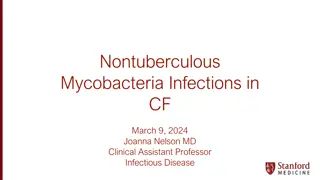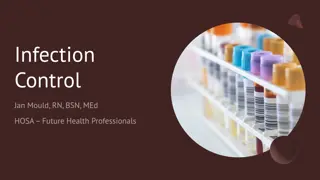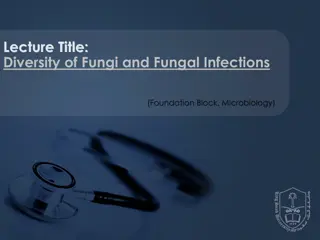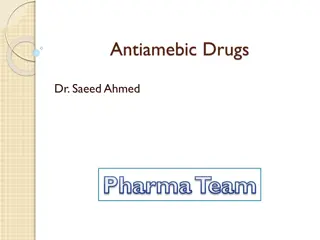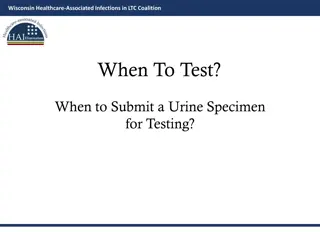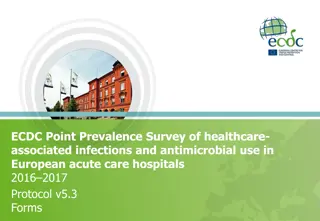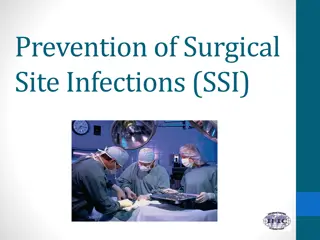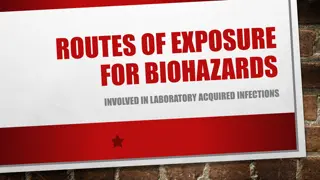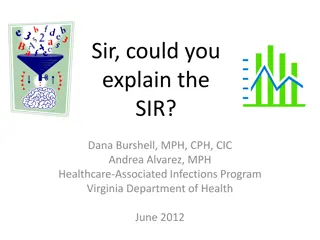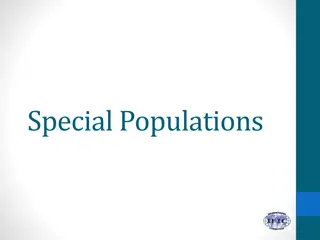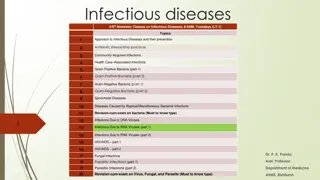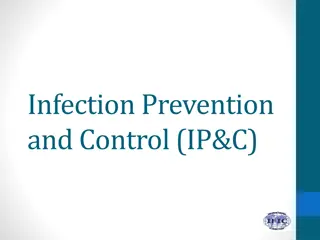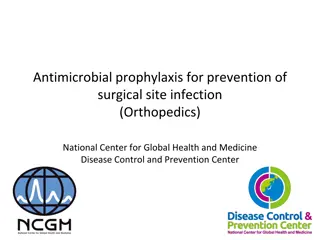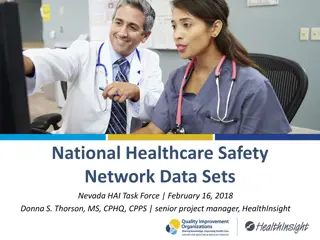Healthcare-Associated Infections Prevention Program: Best Practices
This program by the California Department of Public Health focuses on infection prevention practices during resident positioning and transferring in healthcare settings. It addresses implicit bias, hand hygiene, proper positioning importance, prevention of pressure injuries, and strategies to avoid skin deterioration and infection. The objective is to promote healthcare diversity, equality, and effective infection control measures.
Download Presentation

Please find below an Image/Link to download the presentation.
The content on the website is provided AS IS for your information and personal use only. It may not be sold, licensed, or shared on other websites without obtaining consent from the author.If you encounter any issues during the download, it is possible that the publisher has removed the file from their server.
You are allowed to download the files provided on this website for personal or commercial use, subject to the condition that they are used lawfully. All files are the property of their respective owners.
The content on the website is provided AS IS for your information and personal use only. It may not be sold, licensed, or shared on other websites without obtaining consent from the author.
E N D
Presentation Transcript
1 HEALTHCARE-ASSOCIATED INFECTIONS PROGRAM Turning Point: Infection Prevention Practices While Positioning and Transferring Residents Project Firstline Healthcare-Associated Infections Program Center for Health Care Quality California Department of Public Health
2 HEALTHCARE-ASSOCIATED INFECTIONS PROGRAM Implicit Bias Describes how our unconscious attitudes or judgements can influence our thoughts, decisions, or actions Includes involuntary, unintentional perceptions made without awareness Occurs as our brains sort information and perceive data to understand our world Affects our decisions, contributing to societal disparities Self awareness about implicit bias can promote healthcare diversity and equality Learn more about your own implicit bias at Project Implicit (implicit.harvard.edu/implicit/)
3 HEALTHCARE-ASSOCIATED INFECTIONS PROGRAM
4 HEALTHCARE-ASSOCIATED INFECTIONS PROGRAM
5 HEALTHCARE-ASSOCIATED INFECTIONS PROGRAM Objectives Review proper hand hygiene, personal protective equipment (PPE) use, and cleaning and disinfection practices during positioning or transferring residents Describe why proper positioning is essential to prevent infection Identify ways to prevent infection from pressure injuries Describe strategies to avoid skin deterioration and infection by avoiding friction and shearing
6 HEALTHCARE-ASSOCIATED INFECTIONS PROGRAM Hand Hygiene Hands are the most common way for germs to spread Hand hygiene should be performed before and after transferring or repositioning a resident Perform hand hygiene with alcohol-based hand rub (ABHR) or with soap and water ABHR is appropriate in most situations Use PPE
7 HEALTHCARE-ASSOCIATED INFECTIONS PROGRAM Reflection When would performing hand hygiene with soap and water be required? When would alcohol-based hand rub be okay to use?
8 HEALTHCARE-ASSOCIATED INFECTIONS PROGRAM POSITIONING
9 HEALTHCARE-ASSOCIATED INFECTIONS PROGRAM Positions
10 HEALTHCARE-ASSOCIATED INFECTIONS PROGRAM Knowledge Check Why are positioning and repositioning necessary, and how are they related to infection prevention and control? (Select all that apply) A. Prevent aspiration pneumonia B. Prevent other types of pneumonia C. Prevent catheter-associated urinary tract infections (CAUTI) D. Prevent infected pressure injuries E. All of the above
11 HEALTHCARE-ASSOCIATED INFECTIONS PROGRAM Knowledge Check Why are positioning and repositioning necessary, and how are they related to infection prevention and control? (Select all that apply) A. Prevent aspiration pneumonia B. Prevent other types of pneumonia C. Prevent catheter-associated urinary tract infections (CAUTI) D. Prevent infected pressure injuries E. All of the above
12 HEALTHCARE-ASSOCIATED INFECTIONS PROGRAM Positioning to Prevent Pneumonia Pneumonia is the second most frequent healthcare- associated infection (HAI) in long-term care facilities. Preventing the Most Common HAI, California Department of Public Health (CDPH) (www.cdph.ca.gov/Programs/CHCQ/HAI/Pages/SNF_PreventingCommonHAI.aspx)
13 HEALTHCARE-ASSOCIATED INFECTIONS PROGRAM Recognizing Signs of Pneumonia Increased blood pressure, heart rate, or respiratory rate New onset of abnormal breathing such as gurgling or choking sounds Presence of reflux food or fluid Cough Fever Sweating or shaking chills Shortness of breath Chest pain that gets worse when breathing deeply Loss of appetite Low energy or fatigue
14 HEALTHCARE-ASSOCIATED INFECTIONS PROGRAM Pneumonia Prevention Practices Encourage deep breathing and repositioning Pneumococcal vaccines Keep head of the bed elevated to at least 45 Remain in this position for at least 30 minutes after feeding
15 HEALTHCARE-ASSOCIATED INFECTIONS PROGRAM Positioning to Prevent Urinary Tract Infections (UTI) Visually assess to make sure catheter is not pulled or kinked Remember to keep urine bag below the level of the bladder Repositioning encourages thorough emptying of the bladder
16 HEALTHCARE-ASSOCIATED INFECTIONS PROGRAM Positioning to Prevent Pressure Injuries Pressure injuries result from skin deterioration, often at pressure points Proper positioning promotes circulation and maintains skin integrity
17 HEALTHCARE-ASSOCIATED INFECTIONS PROGRAM Positioning to Prevent Pressure Injuries Pressure injuries result from skin deterioration, often at pressure points Proper positioning promotes circulation and maintains skin integrity What areas on a resident s body have you seen, or would expect to see, pressure injuries develop?
18 HEALTHCARE-ASSOCIATED INFECTIONS PROGRAM Positioning to Prevent Pressure Injuries Pressure injuries result from skin deterioration, often at pressure points Proper positioning promotes circulation and maintains skin integrity
19 HEALTHCARE-ASSOCIATED INFECTIONS PROGRAM Examples of Pressure Areas: Sitting Up Sitting semi-reclined Sitting upright What areas would be most prone to sores when sitting up semi-reclined? Sitting upright?
20 HEALTHCARE-ASSOCIATED INFECTIONS PROGRAM Examples of Pressure Areas: Laying Down Supine Lateral
21 HEALTHCARE-ASSOCIATED INFECTIONS PROGRAM Stages of Pressure Injuries
22 HEALTHCARE-ASSOCIATED INFECTIONS PROGRAM Stage 1 Pressure Injury Skin is red or discolored Skin is not broken Redness or change in color does not fade within 30 minutes of pressure removal
23 HEALTHCARE-ASSOCIATED INFECTIONS PROGRAM Stage 2 Pressure Injury Topmost layer of skin is broken May appear as a blister or abrasion Drainage may or may not be present
24 HEALTHCARE-ASSOCIATED INFECTIONS PROGRAM Stage 3 Pressure Injury Injury through the second layer of skin to the fat tissue Red edges Pus, odor, heat, drainage Black tissue around sore Little to no pain
25 HEALTHCARE-ASSOCIATED INFECTIONS PROGRAM Stage 4 Pressure Injury Injury reaches into muscle and bone Damage to deeper tissues, tendons, and joints Little to no pain Osteomyelitis (bone infection) Sepsis (blood infection) can occur
26 HEALTHCARE-ASSOCIATED INFECTIONS PROGRAM Strategies to Avoid Friction and Shearing Friction is the rubbing of one surface against another Shearing is the friction that results when skin moves in the opposite direction of the bone or muscle, such as when repositioning a resident higher up in the bed Use a draw sheet to help with turning, lifting, or moving in bed Get a coworker to assist Check for and report any changes in resident s skin Always perform hand hygiene before and after transferring a resident
27 HEALTHCARE-ASSOCIATED INFECTIONS PROGRAM Knowledge Check As a CNA, what is something you can do every day to help prevent pressure injuries in your residents? (Select all that apply) A. Be careful to avoid damaging the skin when moving a resident B. Reposition residents at least every two hours in bed and every hour in a wheelchair C. Look for and report any new skin abnormalities
28 HEALTHCARE-ASSOCIATED INFECTIONS PROGRAM Knowledge Check As a CNA, what is something you can do every day to help prevent pressure injuries in your residents? (Select all that apply) A. Be careful to avoid damaging the skin when moving a resident B. Reposition residents at least every two hours in bed and every hour in a wheelchair C. Look for and report any new skin abnormalities
29 HEALTHCARE-ASSOCIATED INFECTIONS PROGRAM How Can CNAs Assist in Pressure Injury Prevention? Repositioning Every 2 hours if in bed Every hour if in a wheelchair Observe and report to nurse any new skin abnormalities (redness, blisters, sloughing of skin)
30 HEALTHCARE-ASSOCIATED INFECTIONS PROGRAM TRANSFERRING
31 HEALTHCARE-ASSOCIATED INFECTIONS PROGRAM PPE Reminder
32 HEALTHCARE-ASSOCIATED INFECTIONS PROGRAM Transferring Moments and Devices Transferring Moments Independent transfer with device Sitting up on the side of the bed Bed to chair Lift transfer Wheelchair to toilet, vehicle, or tub Floor to chair after a fall Transferring Devices Lifting cushion Security pole, cane, walker Transfer boards and benches Gait belts Transfer wheelchair Bed assist bar Transfer sling
33 HEALTHCARE-ASSOCIATED INFECTIONS PROGRAM Transferring from Bed to Wheelchair Perform hand hygiene before and after transfer Use appropriate PPE Considerations: How long will the resident be in chair? Check tubes for any obstruction or kinking Be aware of need to reposition (e.g., perform chair push-ups )
34 HEALTHCARE-ASSOCIATED INFECTIONS PROGRAM Cleaning and Disinfection After Transfer High-touch surfaces Reusable medical devices: Portable commode Gait belts, transfer belts, and boards Wheelchair Walker, cane Mechanical lift Other assist devices Soiled linens Perform hand hygiene
35 HEALTHCARE-ASSOCIATED INFECTIONS PROGRAM Highlights Proper positioning and routine repositioning are critical to preventing infections in residents Always check for any changes in a resident s skin and know how to recognize signs of pressure injuries Be careful to avoid friction and shearing of the skin Perform hand hygiene, don and doff appropriate PPE, and clean and disinfect equipment and surfaces
36 HEALTHCARE-ASSOCIATED INFECTIONS PROGRAM References About Project Firstline | Centers for Disease Control and Prevention (CDC) (www.cdc.gov/infectioncontrol/projectfirstline/about.html) Infection Control Basics | CDC (www.cdc.gov/infectioncontrol/basics/index.html) Pressure Ulcers Among Nursing Home Residents | CDC (www.cdc.gov/nchs/products/databriefs/db14.htm) Preventing the Most Common HAI | California Department of Public Health (CDPH) (www.cdph.ca.gov/Programs/CHCQ/HAI/Pages/SNF_PreventingCommonHAI.aspx)
37 HEALTHCARE-ASSOCIATED INFECTIONS PROGRAM QUESTIONS AND DISCUSSION
38 HEALTHCARE-ASSOCIATED INFECTIONS PROGRAM Project Firstline Resources Visit the Project Firstline Website (www.cdph.ca.gov/Programs/CHCQ/HAI/Pages/ProjectFirstline.aspx) Subscribe to CNA Today A Newsletter for CNA! (cdph-marketing.powerappsportals.com/HAI/HAI-Registration/) Email the Project Firstline AskBox ProjectFirstline@cdph.ca.gov Project Firstline is a national collaborative led by the U.S. Centers for Disease Control and Prevention (CDC) to provide infection control training and education to frontline healthcare workers and public health personnel. The California Department of Public Health Healthcare-Associated Infections (HAI) Program is proud to partner with Project Firstline, as supported through Strengthening HAI/AR Program Capacity (SHARP) funding. CDC is an agency within the Department of Health and Human Services (HHS). The contents of this presentation do not necessarily represent the policies of CDC or HHS and should not be considered an endorsement by the Federal Government.


